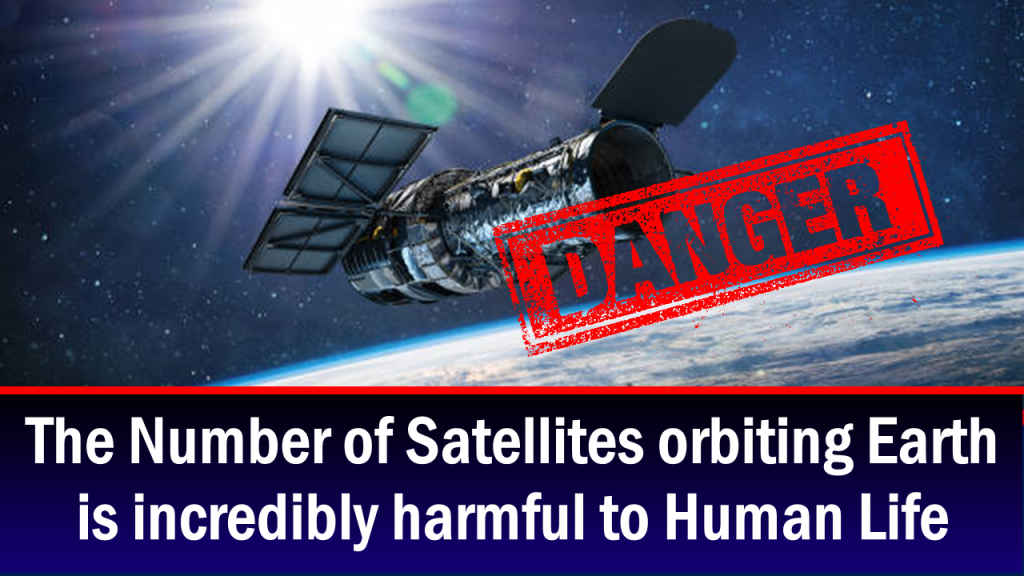-
The Number of Satellites orbiting Earth is incredibly harmful to Human Life

While the attention of a terrified world has been riveted on a virus, and while concern about radiation has been focused on 5G on the ground, the assault on the heavens has reached astronomical proportions. During the past two years, the number of satellites circling the earth has increased from 2,000 to 4,800, and a flood of new projects has brought the number of operating, approved, and proposed satellites to at least 441,449.
The above are the opening lines of a recent 11-page article written by Arthur Firstenberg and published by Cellular Phone Task Force. Firstenberg is the author of ‘The Invisible Rainbow: A History of Electricity and Life’ and Administrator of the International Appeal to Stop 5G on Earth and in Space. In his article, he provides some details of 441,449 low-orbit satellites operating, approved and proposed and the harmful effect these satellites have on life. You can read Firstenberg’s full article HERE.
There is controversy surrounding Firstenberg as highlighted by Claire Edwards. Because of this, we felt it was right to publish both his warning as well as highlight Edwards’ concerns to allow readers to investigate, follow up and decide for themselves.
Firstenberg Controversy
Claire Edwards, an editor on drugs, crime and anti-terrorism, had worked at the United Nations (“UN”), Austria, for 18 years. She especially worked on documents regarding space and worked on the UN Committee on the Peaceful Uses of Outer Space which has a legal subcommittee and a scientific and technical subcommittee. Edwards has a good understanding of Space Law as well as some of the issues regarding space.
She has a dedicated page on her website detailing the ‘Hijack of the International Appeal to Stop 5G on Earth and in Space’. In March 2021 she summed it up in an article:
Low Orbit Satellites
The following are extracts from an article titled ‘441,449 Low Earth Orbit Satellites Operating, Approved and Proposed’ by Arthur Firstenberg published on 5 January 2023.
Firstenberg begins by listing the number of satellite projects worldwide by company. “The companies are based in the United States unless otherwise indicated.” His lists:
- 17,270 satellites that have been already approved by the US Federal Communications Commission (“FCC”), with Amazon (Kuiper) having the highest number at 3,236 satellites.
- Applications for 65,912 satellites pending before the FCC, again Amaazon (Kuiper) has the most at 4,538 additional satellites.
- Constellations totalling 14,892 satellites announced by governments. Guowang, China has the most with 12,992 satellites. To put this extraordinary number into context, the next highest is Roscosmos, Russia with 904.
- Other low-earth-orbit (“LEO”) constellations planned by US and foreign companies, totalling more than 16,055 satellites.
Rwanda, which wants to catapult Africa into world leadership in space, filed an application with the International Telecommunication Union (ITU) on 21 September 2021 for a staggering 327,320 satellites.
Impact on Life
An article published in March 2021 by scientists in Slovakia, Spain and the United States noted that the scattering of sunlight from all of the objects in space is causing a “new skyglow” during the beginning and end of each night that has already brightened the natural night sky by about 10 per cent. The authors are concerned that “the additional contribution of the new satellite mega-constellations” would ruin the night sky to a much greater extent.
Another paper commissioned by the Canadian Astronomical Society and submitted to the Canadian government on 31 March 2021 noted the impact this skyglow will have:
The World’s Largest Garbage Pit
And not only do thousands of whole satellites threaten the heavens, but a phenomenal amount of debris orbits the earth as a result of satellites colliding, exploding, or otherwise being destroyed while in space. During the 64 years that humans have been launching rockets, the protective blankets of the ionosphere and magnetosphere have become the Earth’s largest garbage pit.
According to the European Space Agency, there are, in orbit around the Earth today, 7,790 intact satellites, of which 4,800 are functioning. Since 1957, there have been more than 630 breakups, explosions, collisions, and other satellite-destroying events. This has resulted in the creation of more than 9,700 tons of space debris. There are, in orbit today:
- 30,430 debris objects presently being tracked
- 36,500 objects larger than 10 cm in size
- 1,000,000 objects from 1 cm to 10 cm in size
- 330,000,000 objects from 1 mm to 1 cm in size
Effects on Ozone
In 2021, there were 146 orbital rocket launches to put 1,800 satellites into space. At that rate, to maintain and continually replace 100,000 low-earth-orbit satellites, which have an average lifespan of five years, would require more than 1,600 rocket launches per year, or more than four every day, forever into the future.
2020 and 2021 witnessed two of the largest Antarctic ozone holes since measurements began in 1979. The 2020 hole was also the longest-lasting on record, and the 2021 hole was only a few days shorter; larger than the continent of Antarctica, it began in late July 2021 and ended on December 28, 2021. Everyone is still blaming chlorofluorocarbons (“CFCs”), which were banned by the Montreal Protocol in 1978. Nobody is looking at rocket launches, of which there were more in 2020 and 2021 than in any previous year. In addition to the 146 orbital launches in 2021, there were 143 sub-orbital launches of rockets to over 80 kilometres in altitude, for a total of 289 high-altitude launches for the year, or almost one every day.
Earthquakes and Thunderstorms
The rocket exhaust from every launch emits tons of water vapour, which is more conductive than dry air. The stratosphere is dry and contains very little water, and any water humans put there remains there for years and accumulates. Multiple daily rocket launches, in perpetuity, will fill the stratosphere with water vapour, increase its conductivity, and increase the current flowing in the global electric circuit. The current flowing through the earth’s crust will increase, possibly increasing the frequency of earthquakes. Firstenberg also speculates that this would increase the frequency and power of thunderstorms worldwide.
Earth’s Electromagnetic Environment
A final consideration is the alteration of the Earth’s electromagnetic environment. What everyone is completely blind to is the effect of all the radiation from satellites on the ionosphere, and consequently, on the life force of every living thing, Firstenberg wrote.







Login or Register to Leave a Comment